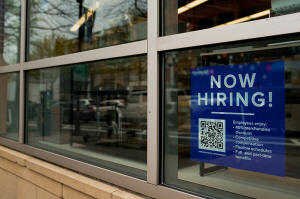Four reasons to take a breath after the U.S. jobs report
 Send a link to a friend
Send a link to a friend
 [August 03, 2024] By
Dan Burns [August 03, 2024] By
Dan Burns
(Reuters) - The disappointing U.S. employment report for July unleashed
a "Freakout Friday" moment in financial markets and triggered a
wholesale resetting of expectations for how much the Federal Reserve
might cut interest rates next month.
There was much to grimace about in the Bureau of Labor Statistics report
card on the job market, including a jump in the unemployment rate to a
post-pandemic high and the weakest pace of private-sector hiring in 16
months.
That said, the report was not without its bright spots like a second
straight month of hefty workforce growth and came with some fat caveats,
including a big debate underway about the weather.
Here are four reasons to take a breath and accept that the report may
not signal the end is near.
BIG BAD BERYL
The BLS added a big footnote to the first page of Friday's release to
say Hurricane Beryl - which slammed into Texas during the employment
report survey week and left some 2.7 million homes and businesses in the
Houston area without power for days - "had no discernible effect" on the
month's data.
A number of economists said: "Whoa!"
For one thing, they said, just look at the number of people who reported
not being at work due to bad weather: 436,000 nonfarm workers and
461,000 with agriculture workers included.

That is not just a record for the month of July, it was more than 10
times the July average dating back to 1976 when BLS started tracking the
metric. And more than 1 million others could only work part time due to
the weather, also a record for the month.
"We are not sure that we absolve Beryl of any responsibility for the
weakness in this data," Jefferies U.S. economist Thomas Simons wrote.
TEMPORARY LAYOFFS
The number of people who said their job loss was temporary was the
highest in about three years last month and accounted for more than half
of the overall increase in the number of unemployed of 352,000.
If their temporary layoffs last only a few weeks or don't become
permanent, economists expect most of those people will report as
employed in the report for August that will come out next month.
[to top of second column] |

An employee hiring sign with a QR code is seen in a window of a
business in Arlington, Virginia, U.S., April 7, 2023.
REUTERS/Elizabeth Frantz/File Photo

Again, Beryl may be a culprit here.
"We think some of those layoffs may have been related to Hurricane
Beryl," Oxford Economics Lead U.S. Economist Nancy Vanden Houten
wrote.
CONSTRUCTION JOBS STILL HUMMING
Construction work, often a leading indicator of coming shifts in the
economy, especially for sectors like home building, continued
growing last month at roughly the pace of the last year.
The 25,000 new jobs was also somewhat above the roughly 20,000
construction jobs added on average each month of the five years
prior to the pandemic, a period Fed officials often reminisce about.
That could augur for a recovery in housing starts, which have been
sluggish for months.
PRIME-AGED PRIME TIME
Economists keep close track of so-called "prime-aged workers" -
those between 25 and 54 years old - because they account for such a
big chunk of the U.S. workforce.
And those prime-agers are trundling back to the labor force in
sizeable numbers.
The prime-aged labor force participation rate rose in July to 84%,
the highest since 2001.
For prime-aged men, their rate ticked up to 90% - the first
nine-handle since the 2007-2009 financial crisis.
And for prime-aged women, it was back to record territory. At 78.1%
last month, the rate matched a record high first set in May.
(Reporting By Dan Burns; Editing by Andrea Ricci)
[© 2024 Thomson Reuters. All rights
reserved.]
This material may not be published,
broadcast, rewritten or redistributed.
Thompson Reuters is solely responsible for this content.
 |